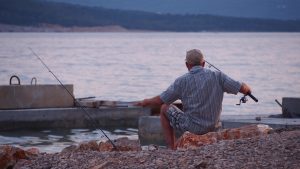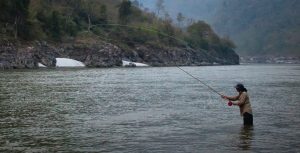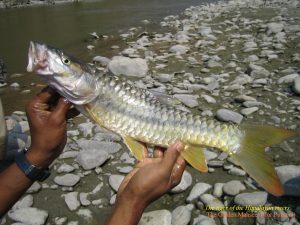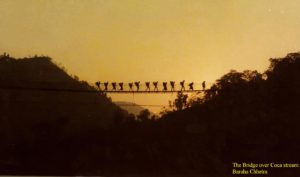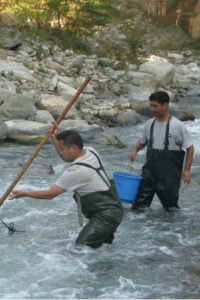
Our team finally arrived at Mai Beni after a five hours hike. The last stretch included a stiff climb on a steep hill with a scary knife’s edge trail hardly a foot wide with Sun Koshi on one side and Arun to the other. In all honesty, with no head for heights, I literally crawled on all fours at places not daring to look down either left or right!
River god
Mai Beni is named after ‘Mai’, the goddess of the river, and ‘Beni’ translates to a confluence of two rivers. Normally, quiet and isolated throughout the year, villagers from near and far throng the riverside hill on the day of Magh Purne (the Full moon day of January) to offer puja (worship) to Mai Beni, which happens to be a small cluster of rocks. Other times, small groups congregate on the river banks to cremate their dead ones.
At Mai Beni, we were to stay at Dan Bahadur Rai’s (Beni Kanchha, to fellow villagers) place. Our bedroom was a shaky loft in his cattle shed. At the dead of night, we could clearly hear the deep rumble of the Sun Koshi which was only a spitting distance away. After a hearty meal, prepared by Beni Kancha’s wife, we retired early so that we could start our fishing with the first light of dawn. Gripped by nervous excitement, I had a fitful sleep, tossing and turning all night.
Angling begins
The next morning, we head to the Sunkoshi. Quiet with no soul around, the atmosphere was almost spooky. The forested hills across seemed to stand sentinel over the turquoise waters of the river. The water felt cool and appeared almost gin clear as I could see the gravel and stones three feet below the water surface.
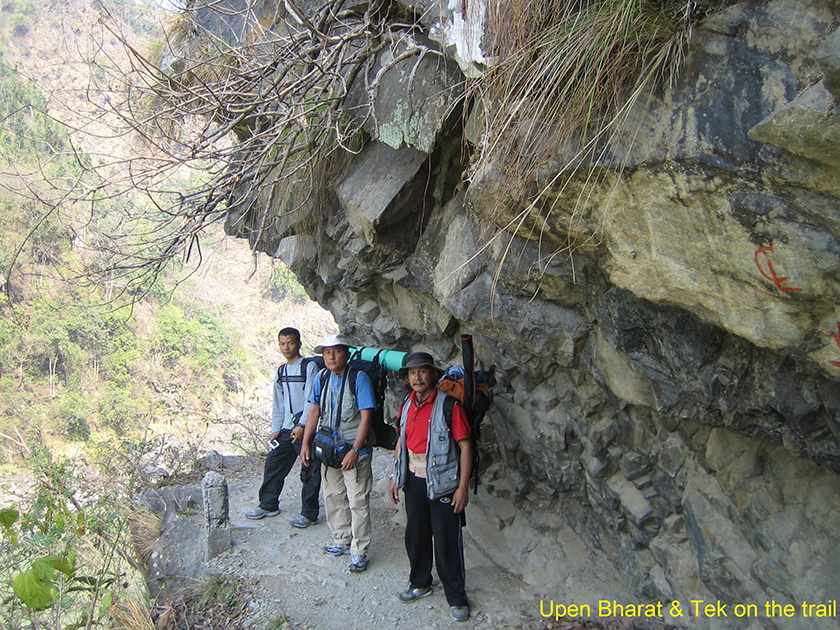
We could hardly believe our luck as within two hours we bagged two golden mahseers. Upen had the first catch that weighed one and a half kilos followed by Bharatji’s, which tipped the hand scale at four kilos. The big mahseer put up a real fight before giving in.
A golden mahseer with its streamlined body and resplendent hues of olive green, silver, yellow and a golden tinge is a beautiful creature to look at—with a mouth that is astonishingly wide.
The atmosphere grew electric and everyone was grinning from ear to ear. After a photo shoot, it was time to release the catches back in the water where they belonged. It was an endearing moment as the big one slowly swam off with a wag of its tail as if it was bidding us farewell.
The next morning, we assaulted the confluence of the Sun Koshi and the Arun. While the Arun looked chalky because of snowmelt high up in the mountains, the Sun Koshi appeared greenish blue. The confluence presented us with our third catch, a golden mahseer again, just over one and a half kilos: courtesy of Prem. Prem did the honours of releasing the catch.
That morning, while casting my line, a strange sight met my eyes. I spotted two guys drifting speedily along out on the Sun Koshi standing upright on a makeshift raft made of bamboo culms lashed together.
They steered the bouncing raft with long bamboo poles. Kanchha told us that they were ferrying the bamboos downstream to sell them at Tarai bazaar. Watching them ride standing up unsteadily on their flimsy raft gave me the shivers, as they had to deal with the intimidating rapids and massive boulders.
That evening Kanchha told us about a recent accident at Tribeni that had taken a man’s life. “The Koshi takes one or two rafters’ lives every other year,” he said.
Mixed bag
Day three and four were downers. Strong gusts, choppy water, and a dust storm followed by an unremitting drizzle made our angling impossible.
During our entire stay at Mai Beni, the Sun Koshi served as the source of our drinking water; we used Piyush (sterilizing solution) to make it safe for drinking. But for two days, our drinking water took on the colour of thin soup as the rains had turned the river murky.
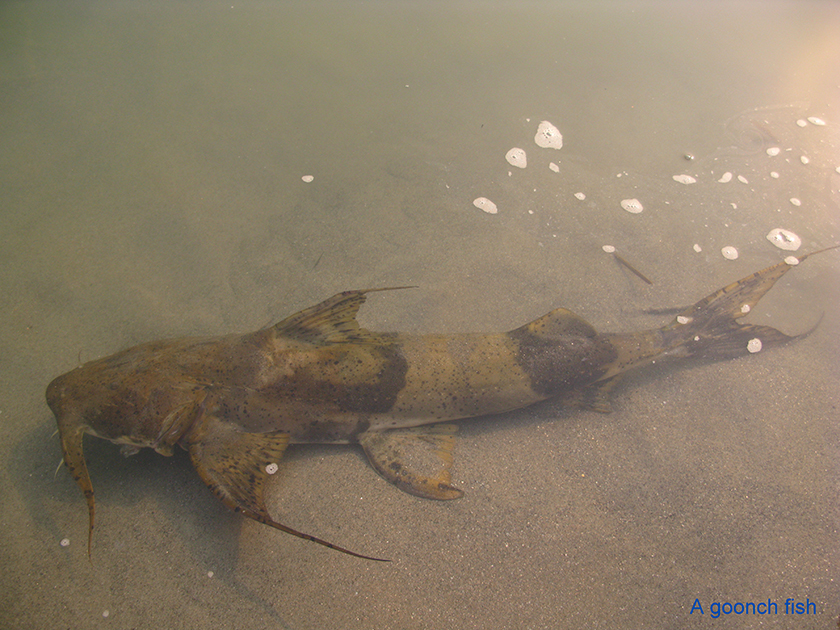
Day five saw some excitement. Our catch included a goonch (catfish) weighing close to two kilos and the ever-lucky Prem bagged a katle (a copper mahseer, a distant cousin of golden mahseer). Both catches were kept back for the camp kitchen.
Day six saw feeble bites and a lot of misses. Then infirmity struck the camp. That night Kanchha’s daughter came down with a high fever, Prem developed gastritis, and Bharat was doubled over with an abdominal pain. But, not to worry—the marvellous Dharan boys had brought a mobile pharmacopoeia with them, and soon everyone was on the mend the next day.
On day seven Upen hooked another golden mahseer weighing a little less than four kilos, but we were a bit dubious about its release because of a slight tear at the lips. “Slight wounds or tears don’t matter,” our team skipper Bharat told us. “They heal up quickly, as the river water contains therapeutic properties,” he said.
We had to make sure the fish would survive after its release. After being tethered on a cotton rope in the water for an hour, the fish seemed to regain its strength and started darting around. So we let him go.
Day eight was a total bust. No fish. So, the following morning we set off to try our luck at the confluence of the Sun Koshi and a stream called Ekuwa, a two-hour walk from Mai Beni. Kanchha suggested taking a shortcut, which scared the living daylights out of me. We had to literally slither like rock climbers on a nearly vertical cliff groping for handholds while the Sun Koshi roared by in a deafening rage only a few feet below us.
Lightning strike
The incredible happened at Ekuwa! Finally, I had a strike on my spoon! The rod was almost torn out of my hands and the reel jumped. With bated breath, I yanked my rod up, my Abu 7000 reel screeched as a couple of yards of 30-pound breaking-strain line spun out.
Then all of a sudden the line went slack. Dammit, I had lost it—just like that! My tough luck! My expert co-mates checked the drag on my reel and figured that the fish must have been over 10 kilos. I stamped my feet hard and swore like anything!

Luck, as it seemed, eluded me all the time for everyone had made a catch so far but for me. Down in the dumps, that night, I nursed my bruised ego with a few extra glasses of kodo ko rakshi (local millet alcohol).
On day 10 we bid Kanchha and his beaming family good-bye and headed back for Dharan. At Baraha Chhetra, we learned that there was a bandh called by the Maoists, so no vehicles plied on the road to Dharan. We decided to stay the night over at Chatara Ghat and take a ride the next morning to Dharan ending our fishing trip to our great relief that we were spared the dreaded Maoist confrontation throughout the tour.
Shortly after my return home to Kathmandu, my Dharan friends on their next trip to Mai Beni met with two incredible sights. At Chatara bazaar, a Gudi (the Gudis are fishermen who live a nomadic life on the banks of the Sapta Koshi at Chatara Ghat) was selling his day’s catch: 12 kilos in all, out of which almost nine kilos were golden mahseer fingerlings. For my fisher friends that was an appalling sight.
But, as if to compensate for this ghastly sight, the next day at the confluence of the Coca and the Sapta Koshi, my friends spotted golden mahseer fingerlings darting around by the thousands in a pool. That was reassuring news. It showed that there was still a glimmer of hope for these great fish.
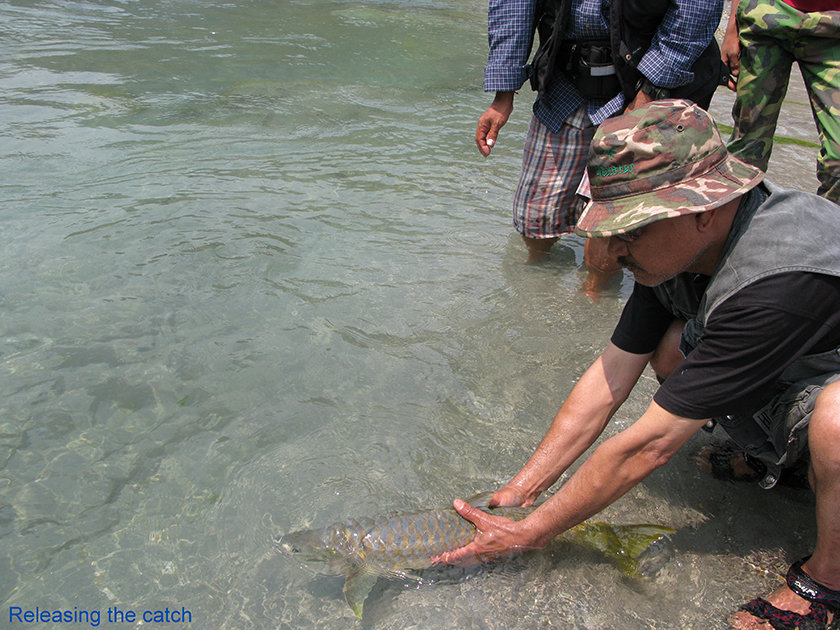
I visited Mai Beni for three more years to relive the adventure and continue my little study of this legendary game-fish extending my exploits deeper into the mighty Sapta Koshi and the mysterious Tammar. The catches, however, got less and less every year.
My fisher friends from Dharan, however, kept up their good work. To save and conserve these species, they still practice ‘catch-n-release’ to this day and untiringly keep trying to bring awareness among the fishing community of the Koshi. Kudos to those unsung heroes!
What is heartening to observe is that more and more Nepali fishers have joined hands to conserve this ‘flagship species’, the Mighty Mahseer--the real tigers of the water. This great species is, however, begging for proper cognizance and attention its terrestrial cousins, the Royal Bengal Tigers, are getting. Tight lines!
End of part 2. Read part one here.
The author can be reached at [email protected]




